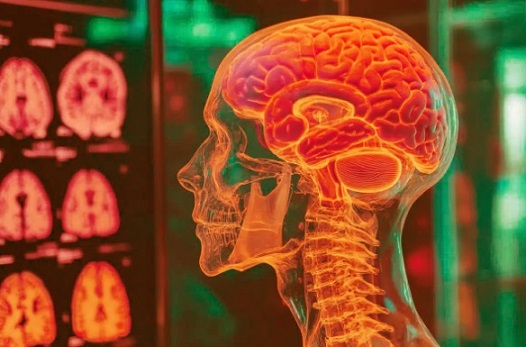Nikhil Prasad Fact checked by:Thailand Medical News Team Jan 13, 2025 3 months, 13 hours, 30 minutes ago
Medical News: In recent years, the medical community has been grappling with the intricate and multifaceted disorders known as Postural Orthostatic Tachycardia Syndrome (POTS) and Long COVID. These conditions, though distinct, appear to share underlying mechanisms and are often interconnected. POTS, a well-documented autonomic nervous system disorder, has become a notable consequence of SARS-CoV-2 infections. Long COVID, on the other hand, encompasses a broader range of persistent symptoms following COVID-19. This
Medical News report delves into groundbreaking research that points to neuroinflammation in the brainstem, particularly in the dorsolateral inferior medulla, as a possible link between these two conditions.
 Neuroinflammation in the Brainstem and its Link to POTS and Long COVID
Understanding the Role of the Brainstem
Neuroinflammation in the Brainstem and its Link to POTS and Long COVID
Understanding the Role of the Brainstem
The brainstem, a critical component of the central nervous system (CNS), serves as the control center for many vital bodily functions. It manages respiratory rhythms, cardiovascular regulation, and autonomic processes. Researchers have long suspected that disruptions in the brainstem might underlie certain autonomic dysfunctions observed in POTS and Long COVID. The dorsolateral inferior medulla, a specific region within the brainstem, has emerged as a focal point of interest.
POTS has been studied extensively over the past three decades. Characterized by an abnormal increase in heart rate upon standing, this condition often causes symptoms such as dizziness, fatigue, and cognitive difficulties. Many of these symptoms overlap with those experienced by individuals suffering from Long COVID. Notably, neuroinflammation within the brainstem has been proposed as a common mechanism for both disorders, providing a new perspective on their shared pathophysiology.
Key Findings from Recent Studies
A pivotal study led by Svetlana Blitshteyn from the Department of Neurology at the University of Buffalo Jacobs School of Medicine and Biomedical Sciences-USA, along with the Dysautonomia Clinic-USA, highlights the significance of neuroinflammation in the dorsolateral inferior medulla. Using advanced neuroimaging techniques, such as ultra-high field 7T MRI, researchers have identified markers of neuroinflammation in the brainstems of patients with post-COVID symptoms. These findings were substantiated by Rua and colleagues, who detected increased susceptibility in the medulla, pons, and midbrain areas -regions integral to autonomic control.
Further insights were derived from pre-pandemic studies, which linked neuroinflammation in the dorsal medulla to pediatric cases of orthostatic intolerance. The researchers hypothesized that this region, home to the nuclei of the vagus nerve, plays a critical role in regulating autonomic functions. This overlap between historical data and contemporary findings underscores the importance of the dorsolateral inferior medulla as a potential central localization for both POTS and Long COVID.
Mechanisms of Neuroinflammation
The neuroinflammation observed in the brainstem could
stem from several factors. Hypoperfusion, or reduced blood flow to the brainstem, is a key mechanism implicated in both POTS and Long COVID. Endothelial dysfunction, microclots, and hypercoagulability - all common features of Long COVID - may damage the small arteries supplying the brainstem, leading to inflammation.
Additionally, alterations in the glymphatic system, responsible for clearing waste from the CNS, could result in toxin accumulation and subsequent neuroinflammation.
The role of immune system dysregulation cannot be overlooked. Hyperactivated mast cells, often seen in POTS, may exacerbate inflammation through the release of histamines and other mediators. This immune response could further disrupt the delicate balance of the autonomic nervous system, amplifying symptoms such as tachycardia, dizziness, and fatigue. Importantly, this cascade of events underscores the interconnectedness of systemic and central processes in these disorders.
Clinical Implications and Future Directions
Understanding the role of neuroinflammation in POTS and Long COVID opens new avenues for diagnosis and treatment. Current diagnostic tools, such as the 10-minute stand test and tilt table test, primarily focus on peripheral symptoms of POTS. However, the incorporation of advanced neuroimaging techniques could provide a more comprehensive view of the CNS involvement. This is particularly relevant given the limitations of standard 3T MRI in detecting subtle changes in the brainstem.
Therapeutically, the findings highlight the need for targeted approaches to mitigate neuroinflammation. Potential treatments include immunomodulatory therapies, mast cell stabilizers, and agents that enhance parasympathetic activity. Non-invasive interventions, such as vagus nerve stimulation, also hold promise in restoring autonomic balance. Additionally, addressing endothelial dysfunction and improving blood flow to the brainstem could have significant therapeutic benefits.
Conclusions
The growing body of evidence linking neuroinflammation in the dorsolateral inferior medulla to POTS and Long COVID represents a paradigm shift in our understanding of these conditions. The shared pathophysiological mechanisms underscore the need for integrated research and treatment strategies. While much remains to be discovered, the identification of the brainstem as a central player offers hope for more effective interventions.
Ultimately, advancing our knowledge of neuroinflammation and its role in autonomic dysfunction will require collaborative efforts across disciplines. Researchers, clinicians, and patients must work together to unravel the complexities of these disorders.
The study findings were published in the peer-reviewed journal: Biomedicines.
https://www.mdpi.com/2227-9059/13/1/166
For the latest COVID-19 News, keep on logging to Thailand
Medical News.
Read Also:
https://www.thailandmedical.news/news/french-scientists-find-that-sars-cov-2-can-replicate-and-persist-in-the-brainstem-for-lengthy-periods
https://www.thailandmedical.news/news/cambridge-study-finds-sars-cov-2-damages-brain-stem-contributing-to-long-covid-issues
https://www.thailandmedical.news/news/covid-19-causes-glymphatic-drainage-dysfunction-and-bbb-disruption-that-contributes-to-neuroaxonal-injury
https://www.thailandmedical.news/news/breaking-covid-19-news-study-alarmingly-finds-that-recovered-individuals-who-only-had-mild-covid-19-exhibit-glymphatic-system-dysfunction
https://www.thailandmedical.news/news/dysfunctions-in-the-vagus-nerve-hypothalamic-pituitary-adrenal-axis-and-mitochondria-underlie-the-complexities-of-long-covid
https://www.thailandmedical.news/news/spanish-study-reveals-the-role-of-vagus-nerve-dysfunction-caused-by-sars-cov-2-in-post-covid-19-conditions
